History
The castle is one of six that the Bishop of Bamberg, Otto I of Mistelbach (1102–1139), procured for the Bishopric of Bamberg in 1122. Nothing is known of its previous occupants or who built it.
The next record of the castle comes from an appendix to the law book of the Bamberg bishop, Frederick of Hohenlohe (1342–1352). This notes that the Bishop of Bamberg, Leopold III of Bebenburg (1353–1363), paid 100 pounds of hellers to Conrad of Egloffstein for the maintenance of the castle.
Between 1353 and 1359 the castle appears to have been an episcopal fief fully occupied by the lords of Egloffstein, whereby in the course of time, part of the castle became their freehold property. In 1522, Conrad XI of Egloffstein transferred the allodial part of the castle to Bamberg bishop, Georg III of Limpurg (1505–1522), as a fief.
In 1525 the castle was razed during the Peasants' War, but was rebuilt by Conz of Egloffstein. On 8 July 1632, during the Thirty Years' War it was destroyed by Croatian troops. Exactly when it was rebuilt is not known. However, it is possible that only the southern part was rebuilt. In 1638 the lords of Egloffstein relinquished the castle from the episcopal fiefdom through an exchange. The Burggaillenreuther line of the lords of Egloffstein died out in 1682 with John (Hans) Philip II of Egloffstein.
In 1684 the lords of Egloffstein sold their allodial part of the castle to Freiherr Karl Friedrich Voit von Rieneck. In 1810 Anton Joseph Freiherr von Horneck purchased the castle. In 1847 it was described as derelict. A renovation of the surviving buildings was carried out at that time by August Horneck von Weinheim. The castles is now in private ownership.
The castle has nothing to do with the robber baron, Eppelein von Gailingen, who was hanged in 1381.

Franconian Switzerland is an upland in Upper Franconia, Bavaria, Germany and a popular tourist retreat. Located between the River Pegnitz in the east and the south, the River Regnitz in the west and the River Main in the north, its relief, which reaches 600 metres in height, forms the northern part of the Franconian Jura (Frankenjura). Like several other mountainous landscapes in the German-speaking lands, e.g. Holstein Switzerland, Märkische Schweiz, or Pommersche Schweiz, Franconian Switzerland was given its name by Romantic artists and poets in the 19th century who compared the landscape to Switzerland. Franconian Switzerland is famous for its high density of traditional breweries.
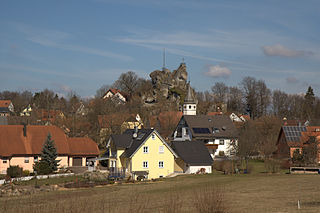
Wichsenstein Castle was a hill castle, once owned by noblemen, on a steep and prominent rock reef (Felsriff) outcrop above the church village of Wichsenstein in the Upper Franconian county of Forchheim in Bavaria, Germany. The castle has been completely demolished and there are no visible remains. The castle rock is now just used as a viewing point.

Gößweinstein Castle, also called Schloss Gößweinstein, is a mediaeval hilltop castle in Gößweinstein in the county of Forchheim in the German state of Bavaria. It towers high above the market town and the River Wiesent and may have been the inspiration for Richard Wagner's grail castle in his opera, Parsifal. The castle is a Bavarian listed building, no. D-4-74-129-10.

Kohlstein Castle is situated on a rocky hillock in the village of Kohlstein northwest of Tüchersfeld and is the most recently built castle in Franconian Switzerland. It is also one of the smallest and most romantic castles. Today it is in private ownership and may not be visited.

The ruins of Upper Tüchersfeld Castle are all that remains of a high medieval castle that once rose high above the valley of the Püttlach in the church village of Tüchersfeld in Germany's Franconian Switzerland. It was built on a spur of the Mittelberg and was one of two castles in the village, the other being the Lower Tüchersfeld Castle.

Lower Tüchersfeld Castle was one of the two castles in the church village of Tüchersfeld in the region of Franconian Switzerland in Bavaria, Germany. The ruins of this spur castle are situated on a rock pinnacle in the centre of the village of Dorfes Tüchersfeld in the municipality of Pottenstein in the Upper Franconian county of Bayreuth. On the rock tower behind it are the remains of Upper Tüchersfeld Castle.

Leienfels Castle was a late mediaeval aristocratic castle, immediately northwest of the eponymous village of Leienfels in the region of Franconian Switzerland in Germany. The village belongs to the borough of Pottenstein in the Upper Franconian county of Bayreuth in Bavaria.

The ruins of Bärnfels Castle are the remains of a late mediaeval aristocratic castle on the southern edge of the village of Bärnfels in the municipality of Obertrubach in the Upper Franconian county of Forchheim in Bavaria. The ruins of the spur castle are freely accessible.

Rabeneck Castle is a former high mediaeval aristocratic castle which stands high above the valley of the Wiesent in the Upper Franconian district of Bayreuth in the German state of Bavaria.

Waischenfeld Castle is a ruined rock castle on a rocky plateau a few metres west of the town of Waischenfeld in the province of Upper Franconia in the German state of Bavaria.
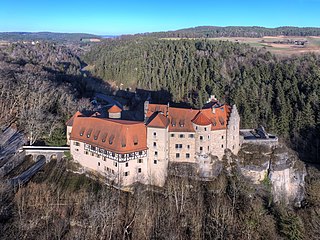
Rabenstein Castle is a former high medieval aristocratic castle in the municipality of Ahorntal in the Upper Franconian county of Bayreuth in the German state of Bavaria.

The ruins of Wolfsberg Castle are the remains of a former high mediaeval, aristocratic, castle which stands high above the Trubach valley over the eponymous village of Wolfsberg. The village is part of the municipality of Obertrubach in the Upper Franconian county of Forchheim in the German state of Bavaria.
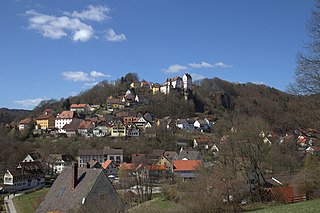
Egloffstein Castle is a former high mediaeval, aristocratic castle, that stands immediately west of the eponymous village of Egloffstein in the Upper Franconian county of Forchheim in the German state of Bavaria.

Schloss Hundshaupten is a quadrangular castle in the village of Hundshaupten in the municipality of Egloffstein in the German county of Forchheim.
The burgstall of Dietrichstein Castle, also called the Diederichstein Ruins, is the site of an old, probably high mediaeval, aristocratic, castle, situated high above the valley of the River Trubach in the municipality of Pretzfeld in the Upper Franconian county of Forchheim in Bavaria, Germany.
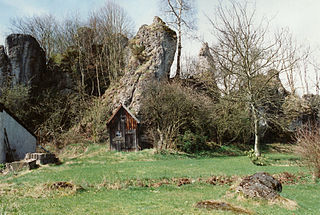
The burgstall or site of Bieberbach Castle is a ruined mediaeval spur castle at a elevation of 530 m above sea level (NN) on a rock formation in the southern part of the parish of Bieberbach, in the market municipality of Egloffstein in the county of Forchheim in the German state of Bavaria.

The burgstall of Wolkenstein Castle is the site of a late medieval aristocratic castle in the village of Wolkenstein, in the borough of Ebermannstadt in the county of Forchheim in the German state of Bavaria. The burgstall is in private hands and may not be visited.

Schloss Kunreuth is situated on the northwestern edge of the eponymous village of Kunreuth which is part of the collective municipality of Gosberg in the county of Forchheim, in the province of Upper Franconia in the south German state of Bavaria.

Schloss Wiesenthau stands on the northeastern edge of the eponymous municipality at the foot of the Ehrenbürg in northern Bavaria. The Renaissance building is a three-winged country house with 4 mid-16th century corner towers and the remains of an enceinte.
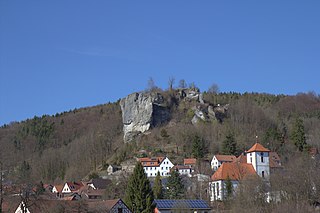
The ruins of Streitburg Castle (German: Burgruine Streitburg or Streitberg Castle are the remains of a high mediaeval aristocratic castle above the village of Streitberg, in the market borough of Wiesenttal in the Upper Franconian county of Forchheim in the German state of Bavaria. They lie directly opposite the ruins of Neideck Castle, the symbol of Franconian Switzerland, on the other side of the valley.






















